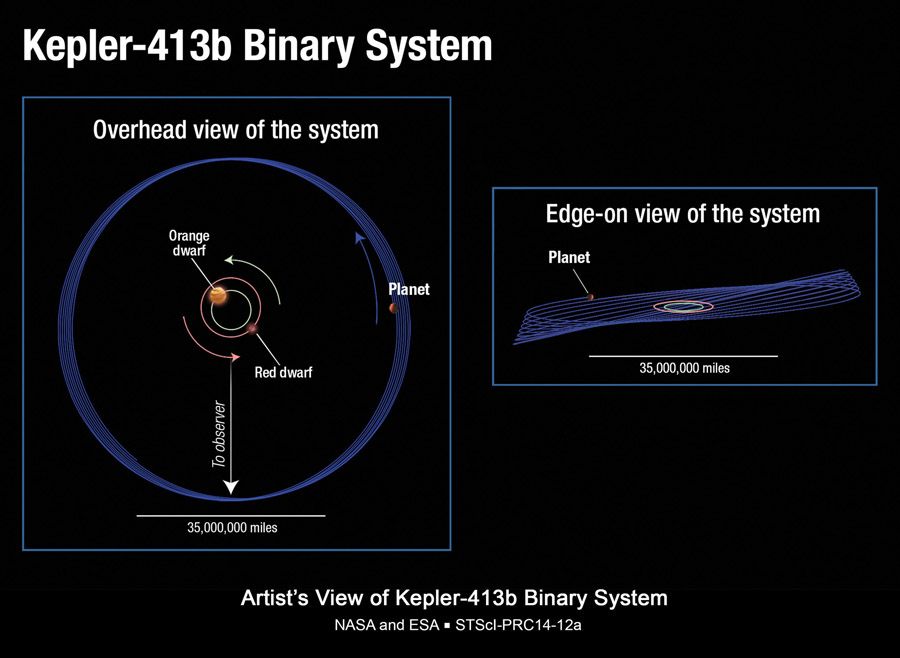Kiwithrottlejockey
Admin Staff
XNC2 GOD

Posts: 32250
Having fun in the hills!
|
 |
« on: February 06, 2014, 08:54:47 am » |
|
From the Los Angeles Times....Meet Kepler-413b: A wobbly planet with strange seasonsBy AMINA KHAN | 7:02PM PST - Tuesday, February 04, 2014 This illustration shows the orbit of planet Kepler-413b around a close pair of orange and red dwarf stars. The planet's tilt could vary as much as This illustration shows the orbit of planet Kepler-413b around a close pair of orange and red dwarf stars. The planet's tilt could vary as much as
30 degrees over 11 years. — Picture: NASA/ESA/A. Feild (STScI).ASTRONOMERS using data from the planet-hunting Kepler Space Telescope have found a wild card of a world: a planet so wobbly that its "seasons" could be in constant flux.
This planet, called Kepler-413b, is about 2,300 light-years away in the constellation Cygnus, and it orbits a binary pair of stars that are circling each other. This gas giant weighing roughly 65 Earth masses orbits every 66 days, too close to the stars to be habitable.
But here’s the unusual bit about this planet, described in an upcoming issue of the Astrophysical Journal: It’s so wobbly that its spin axis could vary by as much as 30 degrees over 11 years — a pretty extreme swing, given that the Earth, tilted at 23.5 degrees, completes one round of its own "wobble" every 26,000 years.
The team discovered this strange system while looking for planets crossing in front of binary stars, said lead author Veselin Kostov, an astrophysicist with Johns Hopkins University and the Space Telescope Science Institute in Baltimore.
NASA’s Kepler telescope, which was retired after it suffered a major injury last year, would stare at a patch of sky and wait for a planet to pass in front of a star and block a little light. When those dips in brightness occur a few times at regular intervals, astronomers know it must be an orbiting planet.
But Kepler-413b was anything but regular. The dips in brightness occurred in weird fits and starts: three times in the first 180 days, then not at all for the next 800 days, then five more times before it stopped again (and then Kepler ceased functioning).
The scientists realized that the planet’s orbit was off by 2.5 degrees — it didn’t travel in the same plane as its host stars, a red dwarf and a slightly larger orange dwarf. The scientists think that, as this uneven pair of stars dance around each other at the center, their different gravitational pulls constantly warp the planet’s orbit. It also causes the planet to wobble on its axis, like a spinning top does — a phenomenon known as rotational precession.
The seasons on this gassy planet, such as they are, would be in constant flux, Kostov said. And this has implications for a detailed definition of habitability. Just because a planet lies in the habitable zone, where liquid water can exist, doesn’t mean it’s an especially friendly place to live — particularly if, say, it’s constantly swinging from hot humid summers to icy winters. It’s another factor to consider as astronomers search for Earth-like exoplanets.
“If you have an Earth-sized planet in the habitable zone of a binary star, you have to take into account this precession,” Kostov said. “It tells us about the architecture of extrasolar planets in general.”
This planet may not be all that unusual; there could be many more like it. After all, Kepler could only see planets regularly transiting at just the right angle; and such wobbly planets are less likely to cross our line of sight.
“My gut tells me there should be more of them like this,” Kostov said. “We just find the ones that are easy to find.”http://www.latimes.com/science/sciencenow/la-sci-sn-planet-wobble-kepler-413b-20140204,0,7930803.story
|
If you aren't living life on the edge, you're taking up too much space!   |
|
|
|


|
|
|
|